
Weekly Online Fanzine
Volume 827

The ERB Artist Profile Series
REX HAYDEN MAXON
(1892-1973)

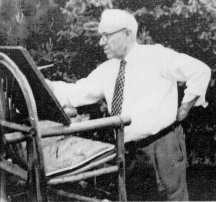



The ERB Artist Profile Series
REX HAYDEN MAXON
(1892-1973)



Harold Foster was the first artist to adapt Tarzan into strip form. It was actually a story strip, consisting of five panels a day with typeset text beneath each panel. Foster drew just 60 daily strips which were reprinted as one of the very first comic books (The Illustrated Tarzan Book No. I - G&D). When United Feature Syndicate, which commissioned the strip, decided to continue the daily Tarzan and Foster was unavailable, they turned instead to staff artist, Rex Maxon

Illustrated Tarzan Book No. 1 ~ G&D & Tarzan of the Apes ~ House of Greystoke
Reprints of Hal Foster's adaptation of Tarzan of the ApesRex Maxon Arrives
Rex Hayden Maxon (1892-1973), son of a house painter, was born in Lincoln, Nebraska on March 24, 1892. When Rex was still a boy, his brother, Paul, and well-known artist-to-be, Clare Briggs, actually studied cartooning together. The Maxon family moved to Webster Groves, a suburb of St. Louis, Missouri. He spent much of his youth sketching the old river steamers on the Mississippi waterfront but his parents thought that one artist in the family was enough and encouraged him to become an electrical engineer. Rex stuck to his dream, however, and obtained a summer job during his high school years painting the river steamboats for the Government. He enrolled for private art lessons from J. LeBrun Jenkins and studied at the St. Louis School of Fine Arts. He later joined the staff of the St. Louis Republic newspaper. After a short period in Chicago, where he studied art at the Art Students League, worked as an idea man for a small ad ajency and did advertising art for the Lord and Thomas Agency. His first job there was drawing shoes for three dollars a week. Inspired by St. Louis Republic colleague Hazel Carter who had moved to New York to work for Evening World paper, he moved east in 1917. Here he lived with Arthur Button in a small studio on 37th Street where they nearly starved to death. He carved out a meagre existence selling theatrical and semi-comic newspaper features to the Evening Mail and later the New York Globe. Rex and Hazel jarried in 1920 and they worked together producing Carter-Maxon features for the New York Glove until it folded. They also did advertising and newspaper serial illustrations using real models for accuracy in their work. During this time Joseph Neebe of Famous Books and Plays, and Max Elser of Metropolitan National Syndicate, impressed with Maxon's experience in working with the human figure, contacted him to try out to carry on the daily Tarzan strip that had been started by Harold Foster. Foster had adapted Burroughs first Tarzan novel, Tarzan of the Apes in early 1929.
Rex Maxon started the daily black and white Tarzan strip on June 10, 1929. Palmer, a writer in Cleveland, plotted out The Return of Tarzan and Rex did the first ten weeks for free. The strip was successful and was sold to United Features Syndicate. Maxon continued to draw the series, almost continuously, for the next 18 years -- a total of 5,200 strips. The adaptations were written by George Carlin and later by Don Garden. Rex took over the scripting during WWII, debuting with the a story involving bats flying out of a cave.
On March 15, 1931, the Tarzan colour Sunday page was inaugurated and Maxon took on this assignment as well. Unfortunately Foster was a hard act to follow. Maxon's inadequacies as an illustrator and storyteller, which may have been acceptable on a black-and-white daily strip, were magnified by the larger colour panels. Many thought him an odd choice as he lacked his predecessor's skill in figure drawing, composition, and several other abilities essential for the drawing of a jungle adventure strip. Edgar Rice Burroughs, especially, disliked Maxon's approach and complained frequently to the syndicate about the strip's art and story lines. He even suggested that Maxon be given photos of animals so he could learn to draw them correctly. Maxon, however, was kept on, possibly because he worked cheap.
In response to Burroughs' complaints, the syndicate brought back Harold Foster to take over the Tarzan colour Sunday pages -- giving Maxon more time to concentrate on the daily strips. This was the start of a very successful run that would stretch from September 27, 1931 through May 2, 1937. Foster then went on to even greater success with his own strip, Prince Valiant.
Between 1929 and 1947 Rex Maxon illustrated all but five of the 27 Tarzan story-strips that were published in newspapers. He continued the strip with original material when the story-strips finally caught up with ERB's output of novels. The Maxon image of Tarzan changed over the years. His original version of the apeman seemed to draw from James Pierce, as he appeared in Tarzan and the Golden Lion. He illustrated him as a handsome figure with short hair and a shoulder-draped leopard skin. Through the years, however, the progression of Tarzan's appearance reflected the public's changing tastes. A clever example of the change in the apeman is evident in Maxon's illustrations for the Tarzan the Untamed storyline. As the strip progressed his hair was shown a little longer each day and he became more savage looking. The draped leopard skin was replaced by a loin cloth. By the end of the story Tarzan had been modernized into the more graceful figure that would be used from then on except for a period in 1936 and 1937. Maxon quit over a pay dispute and William Juhre took over the strip until it started losing money and Rex was asked to return.
On August 27, 1939, the daily strip dropped its original four-panel format with text below and adopted the format still in use today. Most of these numbered daily strips have been reprinted in the English comic, Tarzan Adventures
Many of Maxon's Tarzan drawings have found their way into book form. Almost all of his early works were reprinted in the Whitman Big-Little and Better-Little Books, and some found their way into foreign hard covers such as TARZAN ET LES JOYAUX D'OPAR and TARZAN ET LA VILLE D'IVOIRE, Canadian editions published in French.. 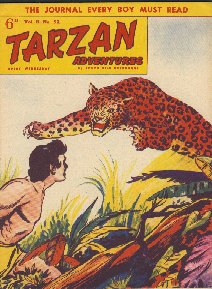
After leaving the Tarzan comic strip in 1947, Rex Maxon worked as a free lancer, mainly illustrating cowboy stories. His work can be found in Young Hawk, the secondary strip of Dell's Lone Ranger comicbook, throughout the 1950s. In 1954 Rex Maxon drew all the interior art for the first issue of Dell's Turok, Son of Stone. He evidently cooperated with editor Matt Murphy in creating the characters of Turok and Andar, and in formulating the prehistoric, Doylesque "Lost Word" that the Indian braves discover. After his contribution to that first issue, Maxon's appearances in Turok were sporatic. Most of the strips, during the comic's first years, were drawn by unsigned artists like Bob Correa, Ray Bailey, Bob Fujitani, and perhaps also Frank Bolle and Samuel J. Glanzman. Rex Maxon generally contributed a four-page "educational" filler strip on prehistoric beasts, entitled "Young Earth," but his work on the Turok strip itself was rarely published.
After Alberto Giolitti took over the Turok comic illustration duties in 1962, Rex Maxon occasionally supplemented the Italian artist's efforts by drawing the magazine's main story. A notable example may be seen in the issue for Sept.-Nov., 1962, where Maxon drew all the interior art, including the Young Earth strip. Whether this work was a contemporary contribution or a restrospective inclusion of earlier, previously unpublished Maxon art remains unclear. Maxon retired from drawing comics a few years prior to his death in 1973, but his work continued to appear in Turok throughout the late 1960s and into early 1970s. He and Hazel moved to London in 1969 where he did water colour painting and worked on portraits. His final years were spent with Hazel and their daughter, Jeanne, about 45 miles from New York, in Rockland County on the Hudson river.


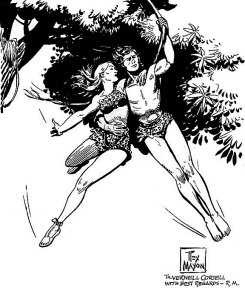
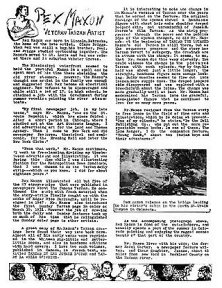
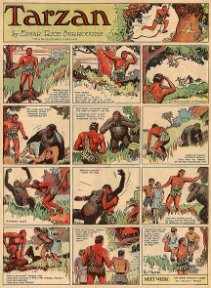
Rex Maxon's First Tarzan Sunday Page March 15, 1931 |

Rex Maxon's Last Tarzan Sunday Page September 20, 1931 |

Transition to Hal Foster Art September 27, 1931 |
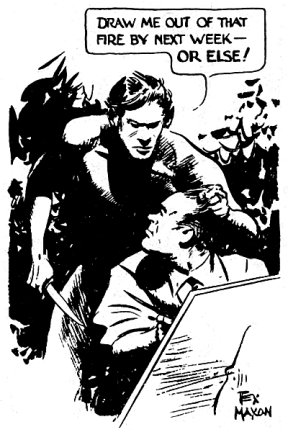
|
|
|
|
|
| Tarzan of the Apes | Hal Foster | R. W. Palmer | January 7, 1929 |
| The Return of Tarzan | Rex Maxon | R. W. Palmer | June 10, 1929 |
| The Beasts of Tarzan | Rex Maxon | R. W. Palmer | August 19, 1929 |
| The Son of Tarzan | Rex Maxon | R. W. Palmer | November 25, 1929 |
| Tarzan and the Jewels of Opar | Rex Maxon | R. W. Palmer | March 17, 1930 |
| Tarzan and the Lost Empire | Rex Maxon | R. W. Palmer | July 14, 1930 |
| Tarzan and the Golden Lion | Rex Maxon | R. W. Palmer | October 20, 1930 |
| Tarzan, Lord of the Jungle | Rex Maxon | R. W. Palmer | February 9, 1931 |
| Tarzan at the Earth's Core | Rex Maxon | R. W. Palmer | June 1, 1931 |
| Tarzan the Terrible | Rex Maxon | R. W. Palmer | September 21, 1931 |
| Tarzan and the Ant Men | Rex Maxon | R. W. Palmer | January 25, 1932 |
| Tarzan the Untamed | Rex Maxon | R. W. Palmer | June 20, 1932 |
| Tarzan the Ape-Man | Rex Maxon | R. W. Palmer | March 27, 1933 |
| Tarzan the Invicible | Rex Maxon | R. W. Palmer | September 4, 1933 |
| Tarzan and the City of Gold | Rex Maxon | Palmer / Garden | March 26, 1934 |
| Tarzan and the Lion Man | Rex Maxon | Don Garden | September 17, 1934 |
| Tarzan and the Fire Gods | Rex Maxon | Don Garden | February 25, 1935 |
| The Tarzan Twins | Rex Maxon | Don Garden | September 2, 1935 |
| Tarzan and the Leopard Men | Rex Maxon | Don Garden | Dec. 30, 1935 |
| Tarzan and the Mayan Goddess | William Juhre | Don Garden | June 22, 1936 |
| Tarzan's Quest | William Juhre | Don Garden | December 14, 1936 |
| Tarzan the Magnificent | William Juhre | Don Garden | June 21, 1937 |
| Tarzan Under Fire | William Juhre | Don Garden | October 11, 1937 |
| Tarzan the Fearless | Rex Maxon | Don Garden | January 17, 1938 |
| Tarzan and the Forbidden City | Rex Maxon | Don Garden | May 9, 1938 |
| Tarzan and the Elephant Men | Rex Maxon | Don Garden | October 10, 1938 |
| Tarzan and the Fires of Tohr | Rex Maxon | Don Garden | February 20, 1939 |
| Rex Maxon | Don Garden | August 28, 1939 | |
| Rex Maxon | Rex Maxon | November 29, 1943 | |
| Dan Barry | Rob Thompson | September 1, 1947 | |
| John Lehti | Rob Thompson | November 22, 1948 | |
| Paul Reinman | Rob Thompson | February 7, 1949 | |
| Nick Cardy | Rob Thompson | February 13, 1950 | |
| Nick Cardy | Burne Hogarth | May 22, 1950 | |
| Bob Lubbers | Burne Hogarth | July 24, 1950 | |
| Bob Lubbers | Dick van Buren | July 31, 1950 |
TARZAN SUNDAY PAGES
|
|
|
|
|
| Rex Maxon | R. W. Palmer | March 15, 1931 | |
| Hal Foster | R. W. Palmer | September 27, 1931 | |
| Hal Foster | George Carlin | November 14, 1931 | |
| Hal Foster | Don Garden | July 1, 1934 | |
| Burne Hogarth | Don Garden | May 9, 1937 | |
| Burne Hogarth | Burne Hogarth | October 31, 1943 | |
| Ruben Moreira | Burne Hogarth | December 2, 1945 | |
| Ruben Moreira | Don Garden | February 10, 1946 | |
| Burne Hogarth | Don Garden | August 10, 1947 | |
| Burne Hogarth | Burne Hogarth | September 14, 1947 | |
| Burne Hogarth | Rob Thompson | December 14, 1947 | |
| Burne Hogarth | James Freeman | July 16, 1950 | |
| Burne Hogarth | Burne Hogarth | July 23, 1950 | |
| Bob Lubbers | Burne Hogarth | August 27, 1950 | |
| Bob Lubbers | Dick Van Buren | September 24, 1950 |
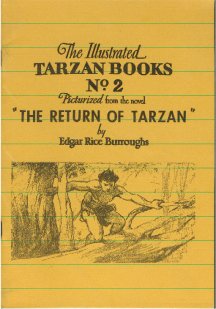
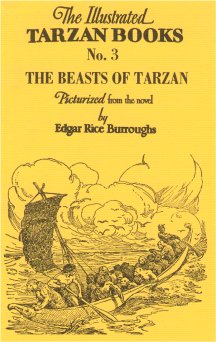
Rex Maxon adapted many of the ERB Tarzan titles to comic strip format,
which in turn were compiled into Whitman Big Little Book editions.
See the
ERB Big Little Book Illustrated Bibliographies
in
https://www.angelfire.com/trek/erbzine3/erbmo44b.html
https://www.angelfire.com/trek/erbzine3/erbmo44c.html
and in the
ERB
C.H.A.S.E.R. Illustrated Bibliography
also
The
Comics Emporium
https://www.angelfire.com/empire/erbcomic/comics19.html
https://www.angelfire.com/empire/erbcomic/comics20.html
https://www.angelfire.com/empire/erbcomic/comics21.html






REFERENCES
The Dale Broadhurst Collection
http://www.lambiek.net/maxon_rex.htm
https://www.angelfire.com/trek/erbzine3/erbmo44a.html
http://cagle.slate.msn.com/hogan/issue1/reviews.asp
http://dlib.lib.ohio-state.edu/cga/pdfs/201-300/0296.30.pdf
THE
COMIC STRIP PROJECT
DREAM
VAULTS OF OPAR
Armstrong
Sperry and Maxon
https://www.angelfire.com/trek/erbzine7/erbz358.html
http://escena.ya.com/tarzana54/tnovedad.html
http://www.unitedmedia.com/comics/tarzan/archive/
Maxon's First
Tarzan Sunday Page
ERB Foreign
Tarzan of the Funnies by Robert R. Barrett
Martin Sheridan, Comics and Their Creators, 1977, pp. 226, 236
P. Couperie & Maurice Horn, A History of the Comic Strip, 1967-68,
p. 131
Maurice Horn, World Encyclopedia of comics, 1976, pp. 486, 650
Comics Between the Panels - Steve Duin & Mike Richardson, 1998.
[p. 304]
The Great American Comic Strip - Judith O'Sullivan, 1990
The Encyclopedia of American Comics, Ron Goulart, editor, 1990 [pp.
255-256]
Vern Coriell's The Burroughs Bulletin #12, 1956
THE REX MAXON TRIBUTE PAGES
|
|
|
|
|
|
Links to over 2,000 of our sites |
Weekly Online Fanzine |
Online Encyclopedia |
Web Museum |
![]() WEBJED:
BILL HILLMAN
WEBJED:
BILL HILLMAN![]()
Bill
& Sue-On Hillman Eclectic Studio
Some
ERB Images and Tarzan© are Copyright ERB, Inc.- All Rights Reserved.
All
Original Work ©1996-2003 by Bill Hillman and/or Contributing Authors/Owners
No
part of this web site may be reproduced without permission from the respective
owners.